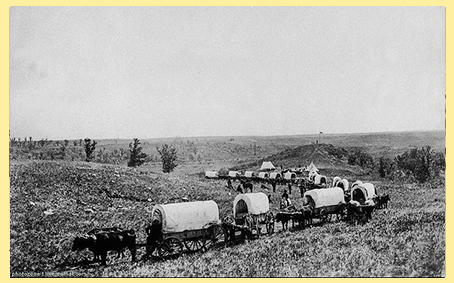Treasure Stories
by James M Deem
Lost Treasure of the Bighorn River
Missing Treasure of Clifford, Colorado

Back to Main Treasure Stories

Treasure hunter Tom Molnar wanted to find Rabbit Hole Springs, a Nevada campsite along the Applegate Trail. This trail was forged by Jesse Applegate after pioneers wanted another, easier route to reach Oregon.  At one point, in August 1846, Applegate and his party had run short of water. Desperate to find some, he noticed rabbit tracks that he thought might lead them to a watering hole. The meager, brackish spring they found was justifiably named for the rabbits.
At one point, in August 1846, Applegate and his party had run short of water. Desperate to find some, he noticed rabbit tracks that he thought might lead them to a watering hole. The meager, brackish spring they found was justifiably named for the rabbits.
Unfortunately, this section of the Applegate Trail wasn't much better than the Donners' route. One wagon train, the Washington City Company, led by J. Goldsborough Bruff, found a most disturbing sight at Rabbit Hole Springs, according to author George R. Stewart.
Emigrants had dug a number of wells . . . three to six feet deep and four or five feet across. Water had oozed in, clear and cool, but a little brackish, about half filling the holes. Unfortunately, half-dead oxen had a habit of wandering around, trying to drink at the wells, falling in headfirst, and drowning. Bruff saw four of the wells thus choked up, the carcasses swelled so as to fit the holes tightly, only the hindquarters and tails showing above the ground. All the ground in the vicinity was littered with carcasses. Though the stench was almost unbearable, Bruff conscientiously counted a dead mule, two dead horses, and eighty-two dead oxen. In addition, there were several lame and abandoned oxen, the wreck of one wagon, fragments of others, and the grave of a fifty-year-old man from Ohio.
The area around Rabbit Hole Springs could have held a number of treasures. But when Molnar and his partner spent three days there, they found nothing of interest. One day as they drove down the road, they tried to imagine what the area looked like almost 150 years ago. It was then that they noticed two faint tracks (that is, a trail) leading west in the direction of Black Rock, the next campsite on the Applegate Trail. They stopped and considered the tracks; they were certain they had stumbled across the original wagon trail.
They drove up the trail a short distance and parked their truck. Then they turned on their metal detectors and began to explore. Five minutes later, Molnar, who was standing over one of the wagon wheel tracks, heard a loud signal as he made his one and only find. The earth was so hard that when he used his trowel, it came up in chunks. He broke the dirt apart and discovered a coin. In the middle of nowhere, on an old wagon-train trail, he had found an 1819 one-cent coin that was as large as a half dollar. It was well worn and worth maybe five dollars. But its history — and the surprise of finding it at all — was far more important. That night, sitting in front of a campfire, Molnar wondered how the coin had been lost there.
Did it fall out of some little boy's or girl's pocket as they walked along beside the wagon? Or was that too much money for a child to have in those days? Maybe it was . . . in a wagon and it bounced out along the bumpy trail. Or was there a fight and it fell out during the skirmish?

Treasure Hint
Look for mentions of transportation routes in old issues of your local newspaper. The older the road, the more likely you are to find treasure there, so steer clear of expressways and highways. The best road hunting may be found along old trails like the Oregon Trail (Missouri to Oregon) and the Natchez Trace Trail (Mississippi to Tennessee), less well known wagon-train trails such as the Applegate Trail, and even stagecoach trails. Old canal routes, such as the Erie Canal, which crisscrossed the mid-Atlantic states, can be found on maps; sites where locks and tollhouses existed are good hunting grounds. Old railroad lines, especially around the sites of railroad stations, may also yield treasures.

Copyright © James M. Deem. Taken from How to Hunt Buried Treasure (Houghton Mifflin, 1994). All rights reserved.